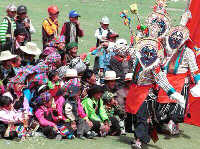
Tibetans are good at singing and dancing. Nearly every Tibetan can sing and dance. People who can talk can sing, and where there is crowd, there is dance. They sing anytime for any event and dance at festivals, weddings, and gatherings as well as in their spare time.
Tibetan dance and song are inseparable twins. If Tibetans sing, they are sure to dance, and they dance while singing.
There are many branches of Tibet dance, which can be roughly divided into four styles: Xie (dance with singing); Zhuo (dance without singing); Ge Er (dance with playing instruments); and Qamo (religious dance).

Based on historical writings, more than a thousand years ago, folk religious and sorcerers' dances were very popular in Tibet, which greatly influenced Tibetan song and dances that have been handed down to this day.
The areas inhabited by Tibetans boasts a great diversity of folk songs and dances, with only some common dances presented as examples: Xie (Guoxie, Guozhuang, Duixie, and Xie dances); Zhuo (Zhuoxie and Rebazhuo dances); and Qamo.
